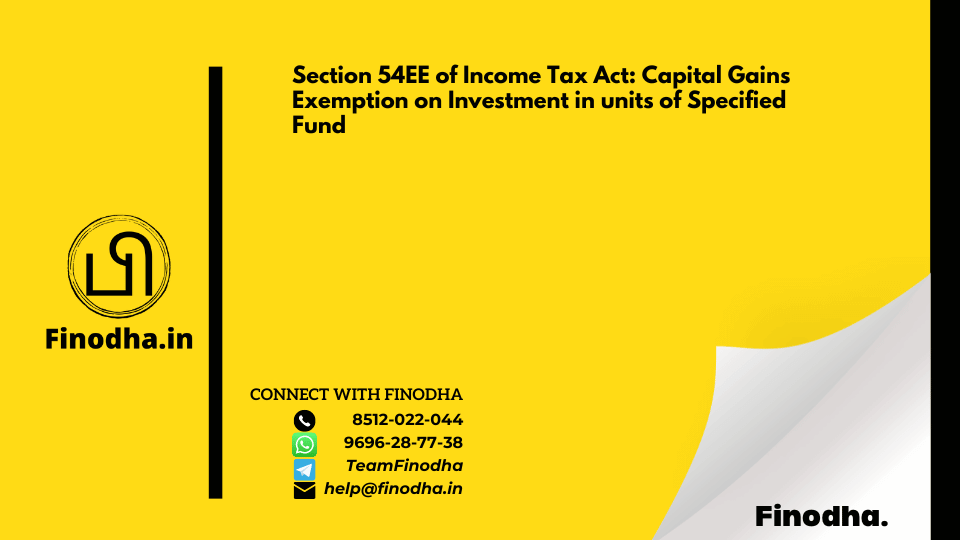Important Keyword: Capital Gains Exemption, Long Term Capital Asset, Section 54EE.
Table of Contents
Section 54EE of Income Tax Act: Capital Gains Exemption on Investment in units of Specified Fund
The Income Tax Department has implemented a new provision, Section 54EE of the Income Tax Act, effective from April 1, 2017. This section offers an exemption from Capital Gains Tax on the sale of any long-term capital asset by reinvesting the proceeds into units of specified funds. Under Section 54EE, the amount of capital gain exemption is determined as the lower of the cost of the new asset, i.e., units of specified funds, or the capital gains from the sale of the long-term capital asset.
This provision aims to encourage investment in specified funds, thereby promoting financial growth and wealth creation opportunities for taxpayers. By providing tax incentives for reinvestment, the government seeks to stimulate investment activity and facilitate the flow of capital into productive sectors of the economy.
Who can claim an exemption under Section 54EE of Income Tax Act?
A taxpayer is eligible to claim an exemption under Section 54EE if they meet the following criteria:
- Any type of assessee, including individuals, Hindu Undivided Families (HUFs), companies, LLPs, and firms, can avail the exemption under Section 54EE.
- The asset sold must be a Long Term Capital Asset (LTCA).
- The taxpayer must invest the Capital Gains within 6 months from the date of transfer of the original asset.
- The investment must be made in units of funds notified by the Central Government on or before April 1, 2019, specifically aimed at financing startups.
- The investment amount cannot exceed INR 50 lakhs during any financial year.
- The investment amount cannot exceed INR 50 lakhs during the current financial year and the succeeding financial year.
Taxpayers can claim the Capital Gains Exemption under Section 54EE while filing their Income Tax Returns (ITRs) for the relevant financial year. They need to use ITR-2 on the income tax website and ensure submission before the due date of July 31st.
What is the amount of exemption available under Section 54EE of Income Tax Act?
As per the provisions of Section 54EE of the Income Tax Act, the exemption amount will be calculated as the lesser of the following:
- The investment amount in new assets, which in this case is the units of specified funds.
- The capital gains on the sale of the long-term capital asset.
Let’s calculate the exemption for Arjun’s case:
- Investment amount in new assets: INR 45,00,000 (the amount invested in units of specified funds).
- Capital gains on the sale of the long-term capital asset: Sale value of commercial property (INR 60,00,000) minus the purchase value (INR 30,00,000) = INR 30,00,000.
In this scenario, the capital gains amount (INR 30,00,000) is less than the investment amount in new assets (INR 45,00,000). Hence, the exemption under Section 54EE will be INR 30,00,000.
Arjun will be able to claim deduction under section 54EE as follows:
| Particulars | Amount |
| Sales Consideration | 60,00,000 |
| Less: Index Cost of Acquisition (30,00,000*317/264) | (36,02,272) |
| Long Term Capital Gains | 23,97,728 |
| Cost of Specified Investment | 45,00,000 |
| Section 54EE Exemption Amount | 23,97,728 |
What happens to exemption if taxpayer sells the 54EE specified investment?
Under Section 54EE of the Income Tax Act, a lock-in period of 3 years applies when claiming an exemption. Let’s explore the consequences of different situations:
Situation 1: Sale of specified investment before 3 years If the taxpayer sells the specified investment within 3 years from the date of purchase, the exemption under Section 54EE is withdrawn. The amount of exemption availed will be subtracted from the cost of the asset. Consequently, the capital gains will be calculated as the total sales value minus the cost of the asset.
If the taxpayer obtains a loan or advance against the security of the specified investment within 3 years from the date of purchase, the asset is considered sold on the date of such loan or advance. Consequently, the exemption under Section 54EE would be withdrawn in such a scenario.
Situation 2: Sale of specified investment after 3 years If the taxpayer sells the specified investment after 3 years from the date of purchase, the exemption under Section 54EE is not withdrawn. The taxpayer will be eligible to claim the index cost of acquisition while calculating capital gains on the investment sold.
Read More: Section 54D: Capital Gains Exemption on Compulsory Acquisition
Web Stories: Section 54D: Capital Gains Exemption on Compulsory Acquisition
Official Income Tax Return filing website: https://incometaxindia.gov.in/




